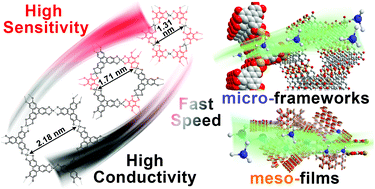A comparative study of honeycomb-like 2D π-conjugated metal–organic framework chemiresistors: conductivity and channels†
Abstract
Two-dimensional (2D) π-conjugated conductive metal–organic frameworks (cMOFs, 2DπcMOF) with modulated channel sizes and a broad conductivity range have been reported in the last decade. In contrast, the corresponding comparative studies on their effects on chemiresistive sensing performances, which measure the resistive response toward external chemical stimuli, have not yet been reported. In this work, we sought to explore the structure–performance relationships of honeycomb-like 2D π-conjugated cMOF chemiresistive gas sensors with channel sizes less than 2 nm (the mass transport issue) and broad conductivity in the range from ∼10−8 S cm−1 to 1 S cm−1 (the charge transport issue). As a result, we found that the cMOF with a lower conductivity facilitates the much more sensitive response toward the charge transfer of the adsorbed gases (relative increases in resistance: R = 63.5% toward 100 ppm of NH3 for the as prepared Cu–THQ sensor with the conductivity of ∼10−8 S cm−1). Interestingly, the cMOF with a medium channel size (Cu–THHP–THQ) exhibited the fastest response speed in sensing, although it contains H2en2+ as neutralizing counterions in the channels. From the evaluation of the pore size distribution, it is found that the overall porosity (meso- & micro-pores) of cMOFs, rather than the pore size of the honeycomb structure, would determine their sensing speed. When comparing the performance of two different morphologies of nanorods (NRs) and nanosheets (NSs), NRs showed a slower response and extended recovery time, which can be ascribed to the slower gas diffusion in the more extended 1D channel. Altogether, our results demonstrate the first systematic studies on the effect of various structural parameters on the chemiresistive sensor performance of cMOFs.

- This article is part of the themed collections: MOFs: Three Decades of Design and Discovery and Spotlight Collection: 2D Materials Chemistry


 Please wait while we load your content...
Please wait while we load your content...